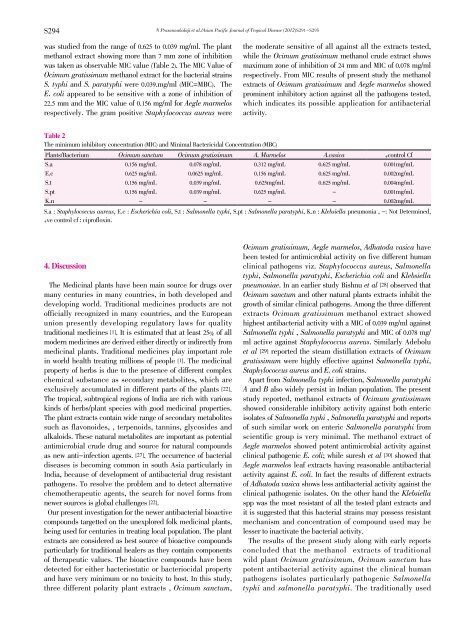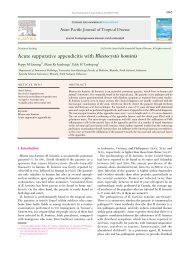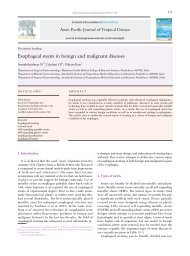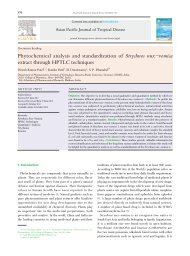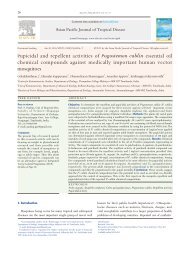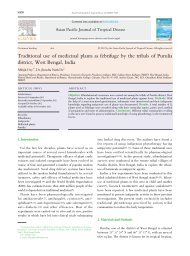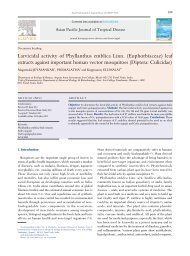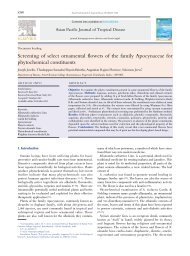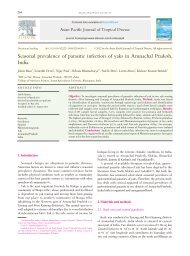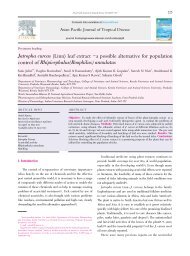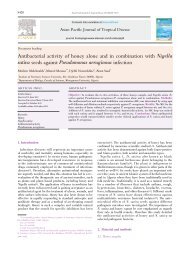Antibacterial activities of some Indian traditional plant extracts
Antibacterial activities of some Indian traditional plant extracts
Antibacterial activities of some Indian traditional plant extracts
Create successful ePaper yourself
Turn your PDF publications into a flip-book with our unique Google optimized e-Paper software.
S294<br />
was studied from the range <strong>of</strong> 0.625 to 0.039 mg/ml. The <strong>plant</strong><br />
methanol extract showing more than 7 mm zone <strong>of</strong> inhibition<br />
was taken as observable MIC value (Table 2). The MIC Value <strong>of</strong><br />
Ocimum gratissimum methanol extract for the bacterial strains<br />
S. typhi and S. paratyphi were 0.039.mg/ml (MIC=MBC). The<br />
E. coli appeared to be sensitive with a zone <strong>of</strong> inhibition <strong>of</strong><br />
22.5 mm and the MIC value <strong>of</strong> 0.156 mg/ml for Aegle marmelos<br />
respectively. The gram positive Staphylococcus aureus were<br />
4. Discussion<br />
The Medicinal <strong>plant</strong>s have been main source for drugs over<br />
many centuries in many countries, in both developed and<br />
developing world. Traditional medicines products are not<br />
<strong>of</strong>ficially recognized in many countries, and the European<br />
union presently developing regulatory laws for quality<br />
<strong>traditional</strong> medicines [1]. It is estimated that at least 25% <strong>of</strong> all<br />
modern medicines are derived either directly or indirectly from<br />
medicinal <strong>plant</strong>s. Traditional medicines play important role<br />
in world health treating millions <strong>of</strong> people [1]. The medicinal<br />
property <strong>of</strong> herbs is due to the presence <strong>of</strong> different complex<br />
chemical substance as secondary metabolites, which are<br />
exclusively accumulated in different parts <strong>of</strong> the <strong>plant</strong>s [22].<br />
The tropical, subtropical regions <strong>of</strong> India are rich with various<br />
kinds <strong>of</strong> herbs/<strong>plant</strong> species with good medicinal properties.<br />
The <strong>plant</strong> <strong>extracts</strong> contain wide range <strong>of</strong> secondary metabolites<br />
such as flavonoides, , terpenoids, tannins, glycosides and<br />
alkaloids. These natural metabolites are important as potential<br />
antimicrobial crude drug and source for natural compounds<br />
as new anti-infection agents. [27]. The occurrence <strong>of</strong> bacterial<br />
diseases is becoming common in south Asia particularly in<br />
India, because <strong>of</strong> development <strong>of</strong> antibacterial drug resistant<br />
pathogens. To resolve the problem and to detect alternative<br />
chemotherapeutic agents, the search for novel forms from<br />
newer sources is global challenges [22].<br />
Our present investigation for the newer antibacterial bioactive<br />
compounds targetted on the unexplored folk medicinal <strong>plant</strong>s,<br />
being used for centuries in treating local population. The <strong>plant</strong><br />
<strong>extracts</strong> are considered as best source <strong>of</strong> bioactive compounds<br />
particularly for <strong>traditional</strong> healers as they contain components<br />
<strong>of</strong> therapeutic values. The bioactive compounds have been<br />
detected for either bacteriostatic or bacteriocidal property<br />
and have very minimum or no toxicity to host. In this study,<br />
three different polarity <strong>plant</strong> <strong>extracts</strong> , Ocimum sanctum,<br />
N Prasannabalaji et al./Asian Pacific Journal <strong>of</strong> Tropical Disease (2012)S291-S295<br />
Table 2<br />
The minimum inhibitory concentration (MIC) and Minimal Bactericidal Concentration (MBC)<br />
the moderate sensitive <strong>of</strong> all against all the <strong>extracts</strong> tested,<br />
while the Ocimum gratissimum methanol crude extract shows<br />
maximum zone <strong>of</strong> inhibition <strong>of</strong> 24 mm and MIC <strong>of</strong> 0.078 mg/ml<br />
respectively. From MIC results <strong>of</strong> present study the methanol<br />
<strong>extracts</strong> <strong>of</strong> Ocimum gratissimum and Aegle marmelos showed<br />
prominent inhibitory action against all the pathogens tested,<br />
which indicates its possible application for antibacterial<br />
activity.<br />
Plants/Bacterium Ocimum sanctum Ocimum gratissimum A. Marmelos A.vasica +control Cf<br />
S.a 0.156 mg/mL 0.078 mg/mL 0.312 mg/mL 0.625 mg/mL 0.001mg/mL<br />
E.c 0.625 mg/mL 0.0625 mg/mL 0.156 mg/mL 0.625 mg/mL 0.002mg/mL<br />
S.t 0.156 mg/mL 0.039 mg/mL 0.625mg/mL 0.625 mg/mL 0.004mg/mL<br />
S.pt 0.156 mg/mL 0.039 mg/mL 0.625 mg/mL - 0.001mg/mL<br />
K.n - - - - 0.002mg/mL<br />
S.a : Staphylococcus aureus, E.c : Escherichia coli, S.t : Salmonella typhi, S.pt : Salmonella paratyphi, K.n : Klebsiella pneumonia , -: Not Determined,<br />
+ve control cf : cipr<strong>of</strong>loxin.<br />
Ocimum gratissimum, Aegle marmelos, Adhatoda vasica have<br />
been tested for antimicrobial activity on five different human<br />
clinical pathogens viz. Staphylococcus aureus, Salmonella<br />
typhi, Salmonella paratyphi, Escherichia coli and Klebsiella<br />
pneumoniae. In an earlier study Bishnu et al [28] observed that<br />
Ocimum sanctum and other natural <strong>plant</strong>s <strong>extracts</strong> inhibit the<br />
growth <strong>of</strong> similar clinical pathogens. Among the three different<br />
<strong>extracts</strong> Ocimum gratissimum methanol extract showed<br />
highest antibacterial activity with a MIC <strong>of</strong> 0.039 mg/ml against<br />
Salmonella typhi , Salmonella paratyphi and MIC <strong>of</strong> 0.078 mg/<br />
ml active against Staphylococcus aureus. Similarly Adebolu<br />
et al [29] reported the steam distillation <strong>extracts</strong> <strong>of</strong> Ocimum<br />
gratissimum were highly effective against Salmonella typhi,<br />
Staphylococcus aureus and E. coli strains.<br />
Apart from Salmonella typhi infection, Salmonella paratyphi<br />
A and B also widely persist in <strong>Indian</strong> population. The present<br />
study reported, methanol <strong>extracts</strong> <strong>of</strong> Ocimum gratissimum<br />
showed considerable inhibitory activity against both enteric<br />
isolates <strong>of</strong> Salmonella typhi , Salmonella paratyphi and reports<br />
<strong>of</strong> such similar work on enteric Salmonella paratyphi from<br />
scientific group is very minimal. The methanol extract <strong>of</strong><br />
Aegle marmelos showed potent antimicrobial activity against<br />
clinical pathogenic E. coli; while suresh et al [30] showed that<br />
Aegle marmelos leaf <strong>extracts</strong> having reasonable antibacterial<br />
activity against E. coli. In fact the results <strong>of</strong> different <strong>extracts</strong><br />
<strong>of</strong> Adhatoda vasica shows less antibacterial activity against the<br />
clinical pathogenic isolates. On the other hand the Klebsiella<br />
spp was the most resistant <strong>of</strong> all the tested <strong>plant</strong> <strong>extracts</strong> and<br />
it is suggested that this bacterial strains may possess resistant<br />
mechanism and concentration <strong>of</strong> compound used may be<br />
lesser to inactivate the bacterial activity.<br />
The results <strong>of</strong> the present study along with early reports<br />
concluded that the methanol <strong>extracts</strong> <strong>of</strong> <strong>traditional</strong><br />
wild <strong>plant</strong> Ocimum gratissimum, Ocimum sanctum has<br />
potent antibacterial activity against the clinical human<br />
pathogens isolates particularly pathogenic Salmonella<br />
typhi and salmonella paratyphi. The <strong>traditional</strong>ly used


